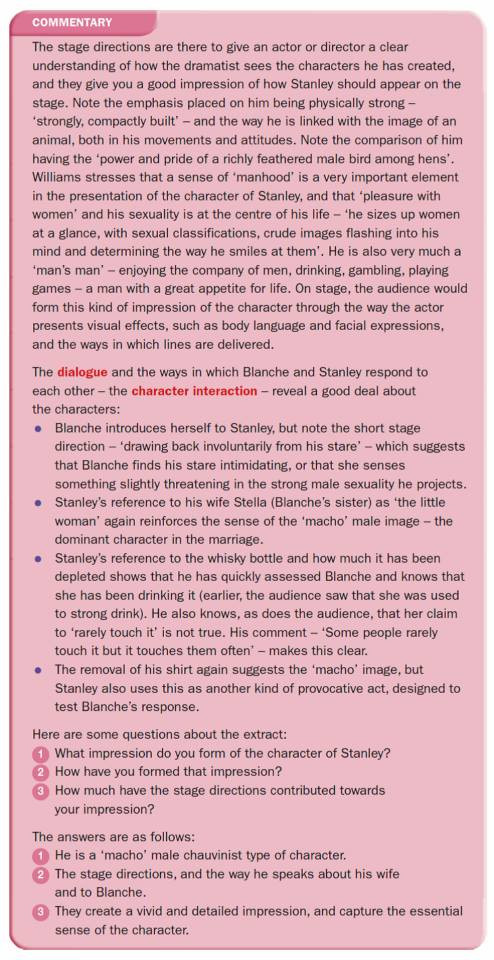Creating Characters
After studying this section, you should be able to:
• recognise the ways in which dramatists present characters to the audience
• identify the techniques used to reveal characters
• apply these ideas to the play you are studying
How Dramatists Present Characters to the Audience
A dramatist can use a range of ways to present various aspects of the characters in a play.
Here are some of the techniques:
• Explicit stage directions can be used, so the dramatist can define explicitly how the characters in the play should be interpreted.
• The appearance of the characters, the clothes they wear and how they appear physically contribute to the impressions we form.
• How the characters speak can reveal important aspects of their characters.
• What characters say about each other can be important.
• What the characters say and do can show a good deal about them.
When writing about how a character is presented, look at the range of evidence that you can draw on from the text to help formulate your ideas.
The Techniques in Action
The Duchess of Malfi
Now look at the extract below, which is taken from The Duchess of Malfi by John Webster. The Duchess – whose ‘crime’ was to re-marry after the death of her first husband – has been imprisoned by her wicked brothers, and she believes that her second husband is dead. Cariola is her faithful lady-in-waiting and Bosola is a treacherous servant to her brothers.
As you read, think about the Duchess’ attitude to death, and how Webster shows this to the audience. How does he show that Cariola’s attitude to death is different to the Duchess’?



A Streetcar Named Desire
Now look at the next extract, which is from A Streetcar Named Desire by Tennessee Williams. Blanche has gone to stay with her sister, Stella. Stella’s husband, Stanley, arrives home and discusses plans for a poker night with his friends, Steve (Eunice’s husband) and Mitch. Read the extract through carefully. Note, in particular, the way that Williams presents Stanley – the way he speaks and behaves, and his attitude towards Blanche.

Comparing the two Examples
You will have noticed some marked differences between the two extracts. In the extract from The Duchess of Malfi, there are very few stage directions, except those that simply describe what actions are meant to be taking place. The impression you form of the Duchess (and the other characters) is very much created by the things that she says and does on stage. In other words, Webster is creating and presenting his characters through the language of the play. Although this is partly true of the extract from A Streetcar Named Desire – we do learn things about Stanley from the way he acts and the things that he says – Williams has supplemented this with a detailed description through the stage directions. These directions give much more than surface detail – they give an insight into the inner man. Phrases like ‘animal joy in his being’ and ‘the power and pride of a richly feathered male bird among hens’ reveal much about the kind of man Stanley is. Obviously, these directions are read in the text, but on stage they would be translated into visual effects.
Writing about Characters
One key point to remember when writing about characters is that you are not writing about ‘real’ people, and so you should avoid describing them as if they were real. They do not have lives of their own, and so the ‘what if they had done that instead of the other?’ type of approach is pointless. They act as they do and are what they are because that is the way that the dramatist created them. The question to ask is ‘Why did the dramatist create and present them in that way?’ Dramatists can use various techniques to present the characters they create. Gather all the details you can from the text, but remember that characters are the creations of the dramatist.

